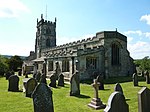Blackburn with Darwen
| Name | Location | Type | Completed [note 1] | Date designated | Grid ref. [note 2] Geo-coordinates | Notes | Entry number [note 3] | Image |
|---|---|---|---|---|---|---|---|---|
| Pleasington Priory | Pleasington | Priory | 1816–19 | 24 November 1966 | SD6428726649 53°44′06″N2°32′34″W / 53.734998°N 2.542857°W | Pleasington Priory (the Church of St Mary and St John Baptist) was built 1816–19. It is constructed of ashlar and has a slate roof. [2] [3] | 1072419 |  |
| Turton Tower | Chapeltown | House | Late medieval | 27 January 1967 | SD7305515220 53°37′58″N2°24′32″W / 53.632804°N 2.408949°W | Turton Tower is a late medieval manor house. [4] [5] | 1241557 |  |







































































